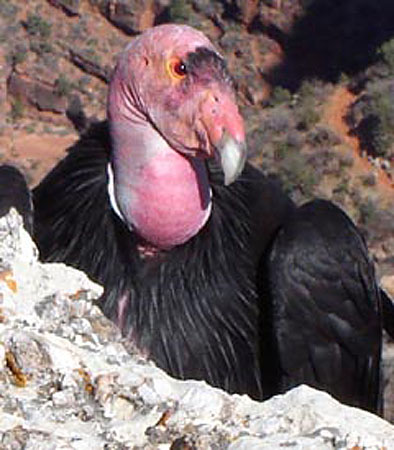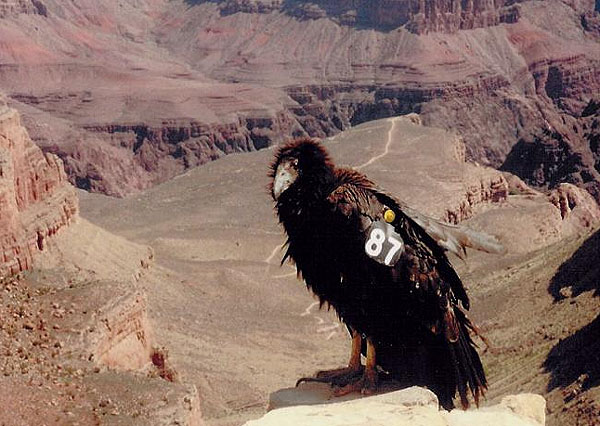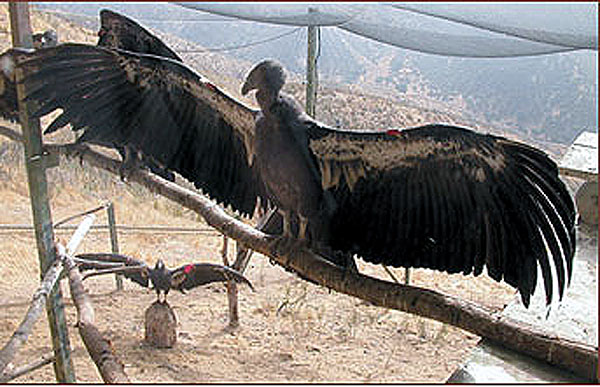California Condor
Gymnogyps californianus
California Condors are one of the largest flying birds in the world, second only to the Andean Condor. They are vultures. In 1987 the species was close to extinction when the last seven birds still in the wild were captured and, with other Condors already in captivity, placed in a propagation program aimed at saving the species from extinction. Through the efforts of a public-private partnership of state and federal wildlife agencies, zoos, and wildlife foundations, the captive and wild population now numbers about 250 birds. Almost all of the birds were introduced from captive breeding and reintroduction programs.

Condor #33 released at the Grand Canyon. Credit: Courtesy NPS

Juvenile condor released at Grand canyon Credit: Courtesy of USFWS

Juvenile being acclimated for release at Pinnacles National Monument. Credit: Courtesy of USFWS
SPECIES IN DETAIL
California Condor
Gymnogyps californianus
CONSERVATION STATUS: Endangered - Protected
CLIMATE CHANGE: Not Applicable
At the Aquarium
The California Condor is illustrated on The Wave’s mosaic tile mural, Rios de la Vida (Rivers of Life). The fountain, mural, and accompanying graphics illustrate the story of our Los Angeles and San Gabriel Rivers. Although not on exhibit in the Aquarium, this bird is included in our website animal database to expand on the information touched on in The Wave fountain exhibit.
Geographic Distribution
There are four wild colonies in central and southern California, Arizona, and Baja California, Mexico, resulting from captive bird breeding programs and reintroduction.
Habitat
These birds are not habitat specialists. They require three ecosystem habitats to meet their needs—areas for nesting, roosting, and feeding, preferably not too far from each other (although they roam many miles when searching for food). They prefer grasslands, chaparral, and scrub oak areas to forage for food. Roosting and nest sites occur mostly in cliff areas and tall trees. They are found near the coast and inland.
Physical Characteristics
These birds have heavy beaks with a distinct hook at the end. Their robust black legs and feet end in heavy toenails, not talons. Adults are black except for white wing linings visible when the birds are soaring. Their head is featherless except for a small black patch of plumage in front of the eyes. Head, bare neck, and crop are usually orange to red in color and become more vividly red during mating season or when the bird is agitated. Female birds have bright red eyes and do not have the fleshy head crests of males.
Newly hatched chicks are light colored with an off-white down covering that is soon replaced with gray down. Juveniles develop dusky black skin and dark feathers. During the third year their head goes through varied color transformations before taking on the adult appearance. Adult plumage does not become complete until the birds are about six years old.
Size
Adult California Condors are 117-134 cm (3.8-4.4 ft) in length with a wingspan of up to 290 cm (9.5 ft). They weigh 10-11 kg (22-25 lbs).
Diet
Condors hunt prey mostly by sight, soaring on thermal updrafts and wind currents until they spot a potential meal. They are vultures and like vultures are carrion eaters, preferring large animal carcasses including domestic animals such as cows, horses, goats, and sheep. Mule deer are favorites, but smaller animals are also eaten. They often eat small bones for a source of calcium, a habit that causes them to confuse man-made objects with bones and eat them.
A Condor may eat up to 1.36-1.8 kg (3-4 lbs) in a day and not eat again for three to four days. They often eat so much at one meal that they have to wait for several hours on the ground before taking off.
Reproduction
Condors reach sexual maturity at about six years of age, but do not always mate that early. When they do mate, it is for life. Breeding commonly takes place between late January and early April. A formal courtship consisting of head-bobbing and wing-rocking side-to-side and up and down precedes mating. During the courtship ritual the pair visits several potential nest sites. Researchers believe that the female selects the site for nesting which usually occurs in rocky cliff areas in holes, under ledges, in crevices, and occasionally in holes in large sequoia trees. Every other year, a single 10.2 cm (4 in) long blue-white or green-white egg is laid. Because this species is somewhat careless in caring for their eggs, breakage is frequent. If the egg is damaged or disappears, a second egg may be produced.
Both parents take part in egg incubation (about 56 days), with the tending parent putting the egg on top of its feet to incubate it. After the chick hatches, both parents participate in its feeding and care for 6-7 months until it fledges and starts to fly. Young adults may rely on parents for food until the following year.
Behavior
Sharp eyes discover food while aloft. Because of their weight, they find it difficult to take off from flat ground and prefer high terrain where they can launch directly into free air. They are expert at soaring and sometimes appear very high in the sky riding thermal currents, possibly for pleasure. They have been observed at altitudes up to 4572 m (15,000 ft) and can reach a flying speed of 88.5 km/hr (55 mi/hr).
Condors are unusually silent. They have no real “voice”, only uttering wheezes or suppressing coughs or grunts. However, when soaring and gliding, wind whistles shrilly as air rushes through their spread, finger-like, primary wing feathers.
Carrion feeders have traditionally been considered dirty, disease bearing animals. To the contrary, Condors are quite fastidious. After eating, they clean their head on grass, branches, or rocks and like to bathe thoroughly in a pool. They then spend several hours preening and drying their feathers. Preening is also a favorite activity while roosting.
Adaptation
The absence of head plumage in these birds is an adaptation to their carrion diet and the way they eat. Their bare heads allow them to poke deeply into the animal carcass without getting too soiled. Their soiled bare head is easily cleaned.
Condors use a form of thermoregulation to conserve energy in which they allow their body temperature to drop several degrees during the night. In the morning they spread their wings to raise their body temperature quickly. They also spread their wings throughout the day when roosting, an activity which helps straighten their feathers which have a tendency to bend from constant flight.
In hot weather Condors defecate on their legs and feet. As the liquid fecal material evaporates, it cools their legs. Their blood circulation transfers the temperature change to other parts of their body.
Longevity
It is believed that few California Condors live longer than 15 years in the wild.
Conservation
Although California Condors historically ranged broadly across North America into northern Baja California, apparently there was never a large population of these birds. Numbers dropped as a result of human migration to the west coast bringing with it activities that affected the population. These included, and still do, human intrusion of habitat, hunting, lead poisoning from ingestion of carrion containing lead shot and poison intended for coyotes, effects of DDT and other chemicals, collection of eggs and specimens for display, loss of prey populations, and construction of telephone and electrical lines with which the birds collide.
In 1981 when only 21 Condors remained in existence, the U. S. Fish and Wildlife Service (USFWS) established a Condor Recovery Plan. In 1987 the wild population became extinct with the capture of the last few wild birds to save them for a captive breeding program. Reintroductions began in 1992 with the release of birds bred in captivity. The continuing breeding program carried on by several agencies has had moderate success. Many of the reintroduced birds have not survived primarily due to collisions with power lines and also as a result of illegal hunting and ingestion of polluted carrion. The present goal of the recovery program is to establish two viable populations of 150 birds each with at least 15 mating pairs.
California Condors are listed as endangered by both the USFWS and California Fish and Game. The IUCN Red List designates them as Critically Endangered.
Special Notes
Initially, reintroduced California Condors were equipped with two battery-powered radio transmitters for tracking purposes. However, these birds go where radio signals drop off and their activities and survival could not be followed. Today, most birds carry a solar powered Global Positioning System (GPS) which sends signals about their movements and whereabouts to a satellite that then sends the signals back down to ground stations for researchers to interpret. The 60 gm (2 oz) transmitter and a colored identification tag are attached to the front of the wing where they do not interfere with the bird’s movements, flight, or safety. The batteries last two years.
SPECIES IN DETAIL | Print full entry
California Condor
Gymnogyps californianus
CONSERVATION STATUS: Endangered - Protected
CLIMATE CHANGE: Not Applicable
The California Condor is illustrated on The Wave’s mosaic tile mural, Rios de la Vida (Rivers of Life). The fountain, mural, and accompanying graphics illustrate the story of our Los Angeles and San Gabriel Rivers. Although not on exhibit in the Aquarium, this bird is included in our website animal database to expand on the information touched on in The Wave fountain exhibit.
There are four wild colonies in central and southern California, Arizona, and Baja California, Mexico, resulting from captive bird breeding programs and reintroduction.
These birds are not habitat specialists. They require three ecosystem habitats to meet their needs—areas for nesting, roosting, and feeding, preferably not too far from each other (although they roam many miles when searching for food). They prefer grasslands, chaparral, and scrub oak areas to forage for food. Roosting and nest sites occur mostly in cliff areas and tall trees. They are found near the coast and inland.
These birds have heavy beaks with a distinct hook at the end. Their robust black legs and feet end in heavy toenails, not talons. Adults are black except for white wing linings visible when the birds are soaring. Their head is featherless except for a small black patch of plumage in front of the eyes. Head, bare neck, and crop are usually orange to red in color and become more vividly red during mating season or when the bird is agitated. Female birds have bright red eyes and do not have the fleshy head crests of males.
Newly hatched chicks are light colored with an off-white down covering that is soon replaced with gray down. Juveniles develop dusky black skin and dark feathers. During the third year their head goes through varied color transformations before taking on the adult appearance. Adult plumage does not become complete until the birds are about six years old.
Adult California Condors are 117-134 cm (3.8-4.4 ft) in length with a wingspan of up to 290 cm (9.5 ft). They weigh 10-11 kg (22-25 lbs).
Condors hunt prey mostly by sight, soaring on thermal updrafts and wind currents until they spot a potential meal. They are vultures and like vultures are carrion eaters, preferring large animal carcasses including domestic animals such as cows, horses, goats, and sheep. Mule deer are favorites, but smaller animals are also eaten. They often eat small bones for a source of calcium, a habit that causes them to confuse man-made objects with bones and eat them.
A Condor may eat up to 1.36-1.8 kg (3-4 lbs) in a day and not eat again for three to four days. They often eat so much at one meal that they have to wait for several hours on the ground before taking off.
Condors reach sexual maturity at about six years of age, but do not always mate that early. When they do mate, it is for life. Breeding commonly takes place between late January and early April. A formal courtship consisting of head-bobbing and wing-rocking side-to-side and up and down precedes mating. During the courtship ritual the pair visits several potential nest sites. Researchers believe that the female selects the site for nesting which usually occurs in rocky cliff areas in holes, under ledges, in crevices, and occasionally in holes in large sequoia trees. Every other year, a single 10.2 cm (4 in) long blue-white or green-white egg is laid. Because this species is somewhat careless in caring for their eggs, breakage is frequent. If the egg is damaged or disappears, a second egg may be produced.
Both parents take part in egg incubation (about 56 days), with the tending parent putting the egg on top of its feet to incubate it. After the chick hatches, both parents participate in its feeding and care for 6-7 months until it fledges and starts to fly. Young adults may rely on parents for food until the following year.
Sharp eyes discover food while aloft. Because of their weight, they find it difficult to take off from flat ground and prefer high terrain where they can launch directly into free air. They are expert at soaring and sometimes appear very high in the sky riding thermal currents, possibly for pleasure. They have been observed at altitudes up to 4572 m (15,000 ft) and can reach a flying speed of 88.5 km/hr (55 mi/hr).
Condors are unusually silent. They have no real “voice”, only uttering wheezes or suppressing coughs or grunts. However, when soaring and gliding, wind whistles shrilly as air rushes through their spread, finger-like, primary wing feathers.
Carrion feeders have traditionally been considered dirty, disease bearing animals. To the contrary, Condors are quite fastidious. After eating, they clean their head on grass, branches, or rocks and like to bathe thoroughly in a pool. They then spend several hours preening and drying their feathers. Preening is also a favorite activity while roosting.
The absence of head plumage in these birds is an adaptation to their carrion diet and the way they eat. Their bare heads allow them to poke deeply into the animal carcass without getting too soiled. Their soiled bare head is easily cleaned.
Condors use a form of thermoregulation to conserve energy in which they allow their body temperature to drop several degrees during the night. In the morning they spread their wings to raise their body temperature quickly. They also spread their wings throughout the day when roosting, an activity which helps straighten their feathers which have a tendency to bend from constant flight.
In hot weather Condors defecate on their legs and feet. As the liquid fecal material evaporates, it cools their legs. Their blood circulation transfers the temperature change to other parts of their body.
It is believed that few California Condors live longer than 15 years in the wild.
Although California Condors historically ranged broadly across North America into northern Baja California, apparently there was never a large population of these birds. Numbers dropped as a result of human migration to the west coast bringing with it activities that affected the population. These included, and still do, human intrusion of habitat, hunting, lead poisoning from ingestion of carrion containing lead shot and poison intended for coyotes, effects of DDT and other chemicals, collection of eggs and specimens for display, loss of prey populations, and construction of telephone and electrical lines with which the birds collide.
In 1981 when only 21 Condors remained in existence, the U. S. Fish and Wildlife Service (USFWS) established a Condor Recovery Plan. In 1987 the wild population became extinct with the capture of the last few wild birds to save them for a captive breeding program. Reintroductions began in 1992 with the release of birds bred in captivity. The continuing breeding program carried on by several agencies has had moderate success. Many of the reintroduced birds have not survived primarily due to collisions with power lines and also as a result of illegal hunting and ingestion of polluted carrion. The present goal of the recovery program is to establish two viable populations of 150 birds each with at least 15 mating pairs.
California Condors are listed as endangered by both the USFWS and California Fish and Game. The IUCN Red List designates them as Critically Endangered.
Initially, reintroduced California Condors were equipped with two battery-powered radio transmitters for tracking purposes. However, these birds go where radio signals drop off and their activities and survival could not be followed. Today, most birds carry a solar powered Global Positioning System (GPS) which sends signals about their movements and whereabouts to a satellite that then sends the signals back down to ground stations for researchers to interpret. The 60 gm (2 oz) transmitter and a colored identification tag are attached to the front of the wing where they do not interfere with the bird’s movements, flight, or safety. The batteries last two years.

